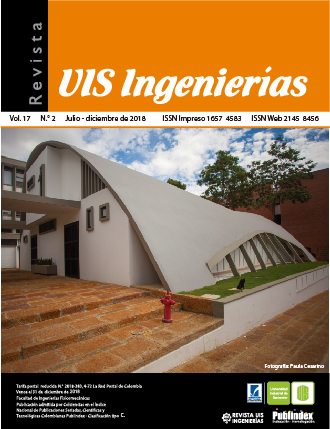Structural simulation of 2D aluminium foam images by the use of homogenization and machine learning techniques
Published 2018-05-07
Keywords
- homogenization,
- aluminium foam,
- neural network,
- machine learning
How to Cite
Abstract
The use of resistant, rigid, low-weight materials with good both acoustic and thermal properties is very interesting in today’s industry. Among these materials, one can find aluminium foams, whose mechanical behaviour is necessary for their application. In order to obtain the geometry of an aluminium foam, several techniques can be applied, and all of them are based in the fact that information is initially obtained by a Computed Axial Tomography (CAT). One of these techniques, known as segmentation, involves a CAD being generated from an image in order to build the Finite Element (FE) model. Another option is to use techniques such as CutFEM or cgFEM, in which a certain amount of pixels, which define the properties of the material, are embedded in each element. Among the existing methods for evaluating the material properties matrix, this study proposes the use of homogenization techniques, spedup by the use of machine learning techniques. This method has been applied to real problems obtain in gahigh speed up, conserving precision.
Downloads
References
J. Banhart, “Aluminum foams for transport industry,” Materials and Design, vol. 18, pp. 217–220, 1997.
J. Parvizian, A. Düster, and E. Rank, “Finite cell method,” Computational Mechanics, vol. 41, no. 1, pp. 121–133, sep 2007. [Online]. Available: http://link.springer.com/10.1007/s00466-007-0173-y
A. Düster, J. Parvizian, Z. Yang, and E. Rank, “The finite cell method for three-dimensional problems of solid mechanics,” Computer Methods in Applied Mechanics and Engineering, vol. 197, no. 45-48, pp. 3768–3782, aug 2008. [Online]. Available: http://www.sciencedirect.com/science/article/pii/S0045782508001163
L. Giovannelli, J. J. Ródenas, J. M. Navarro, and M. Tur, “Direct medical image-based finite element modelling for patient-specific simulation of future implants,” Elsevier Ltd, 2017.
E. Nadal, “Cartesian grid FEM (cgFEM): High performance hadaptive FE analysis with ecient error control. Application to structural shape optimization,” Ph.D. dissertation, Universitat Politècnica de València, 2014.
M. Tur, J. Albelda, O. Marco, and J. J. Ródenas, “Stabilized method of imposing Dirichlet boundary conditions using a recovered stress field,” Computer Methods in Applied Mechanics and Engineering, vol. 296, pp. 352–375, aug 2015. [Online]. Available: http://www.sciencedirect.com/science/article/pii/S0045782515002467
M. Tur, J. Albelda, E. Nadal, and J. J. Ródenas, “Imposing Dirichlet boundary conditions in hierarquical cartesian meshes by means of stabilized Lagrange multipliers,” International Journal for Numerical Methods in Engineering, vol. Accepted, 2013.
[Online]. Available: https://es.mathworks.com/help/images/ discrete-cosine-transform.html
M. Lobo and M. E. Pérez, “Problemas de homogeneización en la ingeniería. Una experimentación numérica,” Revista Internacional de Métodos Numéricos para Cálculo y Diseño en Ingeniería, vol. 7, no. 4, pp. 455–472, 1991.
J. Schröder, “Constraint/boundary conditions on the microscale,” A numerical two-scale homogenization scheme: the FE2- method, Udine, 2014.
M. Hagan and M. B. Menhal, “Training feedforward networks with the marquardt algorithm,” IEEE transactions on neural network, vol. 5, no. 6, pp. 989–993, 1994.
I. W. Sandberg, “Feedworward neural networks: An introduction,” Nonlinear Dynamical Systems: Feedforward Neural Network Perspectives, Wiley and Sons, 2001.
H. Damuth and M. Beale, “Faster training,” Neural Network Toolbox User Guide, The MathWorks, Inc, 2002.

